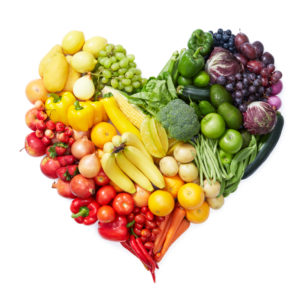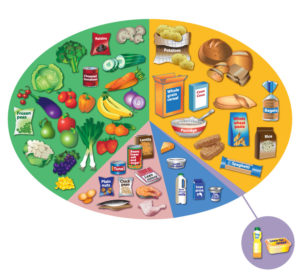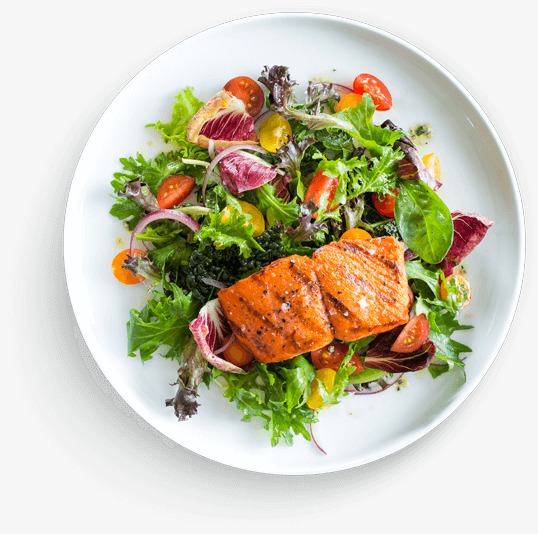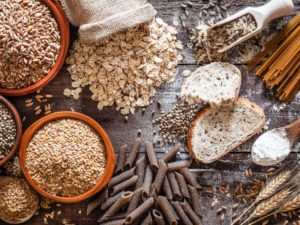
Key principles to healthy eating
The area of nutrition can seem daunting and highly complicated, and the situation isn’t helped by all the myths and misconceptions that we hear every day.
Given the numerous fad diets that are advertised that promise miracle weight loss, or the frequent, often-contradictory, government advice on whether a food is “good” or “bad”, it is no wonder many people are left confused and do not know where to start.
The good news is that basic nutritional principles for eating healthily are really quite simple.
The official UK government advice is based around the “eatwell plate”, which visually represents the proportion that each food group should contribute to your daily intake. Put simply, this means roughly 30-40% your plate should consist of crunchy or leafy vegetables or salads (broccoli, green beans, carrots, tomato etc.). And before you ask, no, unfortunately chips do not count.
The other 60-70% of your plate should be split between starchy root vegetables (potatoes, turnips, swede, sweet potatoes) or wholegrains (whole oats, quinoa, whole grain cereals, brown bread), lean choices of protein (Fish, chicken, turkey, eggs, pulses) and dairy & healthy fats such as nuts, seeds and oils.
However, even this advice can be slightly confusing. Therefore, to keep it as straightforward as possible, just try to remember the five key tips I have laid out below.
Cook rather than re-heat
Whenever possible try to cook from fresh ingredients. You really can’t go wrong if the majority of your meals contain a portion of grilled meat or fish with a plateful of vegetables on the side. Follow this with fresh fruit or natural yoghurt, sweetened with honey, and you have a quick, simple and nutritional meal. This is a much better choice than heating up a pre-packaged processed meal, most of which contain more calories and far fewer nutrients.
Be colourful
As a general rule, the more colourful a natural food is, the more vitamins & minerals it contains (please note that colourful foods such as cupcakes, sweets, ice-cream or donuts are not considered natural). Think dark green beans, vibrant red berries, juicy oranges or yellow peppers. By frequently eating a host of colourful foods, you can ensure that you get the variety of micronutrients that your body needs.
Be sugar-wise
Sugar has been demonized recently but in its natural state sugar is pretty harmless, even necessary.
We all need sugar to use as fuel for our bodies to function. It is found in all complex carbohydrates, including fruits and vegetables, as well as in dairy products such as milk.
The bigger problem comes from Added Sugar, which is when sources of sugar are added to food, taking sugar levels above their natural state. This is often to enhance flavour or to help preserve the food. Added sugars tend to be energy rich but nutrient poor. They also drive up a hormone called insulin, which promotes the storage of excess energy as fat.
The best tip for keeping a handle on sugar? NHS guidelines advise that adults should have no more than 8 teaspoons of sugar per day and children should be limited to 5. Therefore, divide the amount shown on the packet by 4 and you get the number of teaspoons per portion. The results can be eye-opening, would you really pour 5 extra teaspoons of sugar into your pasta sauce or on top of your bowl of cereal?
Make it whole grain
Carbohydrates have been targeted by many as the source of obesity and with popular diets like The Atkins & Keto, many people now try to  severely restrict or indeed eliminate them from their diet altogether. However, eating the right carbohydrates can be healthy, as they not only provide a source of slow release fuel and increase the feeling of fullness (satiety) but are also a great source of fibre.
severely restrict or indeed eliminate them from their diet altogether. However, eating the right carbohydrates can be healthy, as they not only provide a source of slow release fuel and increase the feeling of fullness (satiety) but are also a great source of fibre.
So how do you know which carbohydrates to go for? Well, if you stick to anything brown then you won’t go too far wrong. So instead of trying to eliminate carbs, choose brown whole-grain options, like whole wheat pasta, brown rice and wholemeal bread instead of their white counterparts.
Go for a balanced diet
Eating healthily doesn’t mean not being able to enjoy all your favourite foods. Let’s face it, pizza, chocolate, biscuits and cakes are all delicious and life would be boring without them. So don’t try to cut them out altogether, as that is both unsustainable and unrealistic. Instead use moderation and treat yourself occasionally. Over the long term, if you eat sensibly 80% of the time and limit treats & indulgences to the other 20%, then you’ve got a great recipe for eating well.
